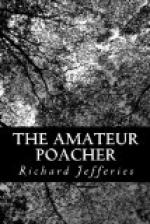By the pond stood a low three-sided merestone or landmark, the initials on which were hidden under moss. Up in the tree, near the gun, there was a dead branch that had decayed in the curious manner that seems peculiar to oak. Where it joined the trunk the bark still remained, though covered with lichen, and for a foot or so out; then there was a long space where the bark and much of the wood had mouldered away; finally, near the end the bough retained its original size and the bark adhered. At the junction with the trunk and at the extremity its diameter was perhaps three inches; in the middle rather less than half as much. The grey central piece, larger and darker at either end, suggested the thought of the bare neck of a vulture.
Far away, just rising above the slope of the leaze, the distant tops of elms, crowded with rooks’ nests (not then occupied), showed the site of the residence of an old gentleman of whom at that time we stood in much fear. The ‘Squire’ of Southlands alarmed even the hardened carters’ lads as much by the prestige of a singular character as by the chastisement he personally gave those who ventured into his domain. Not a bird’s nest, not a nut, must be touched: still less anything that could be called game. The watch kept was so much the stricter because he took a personal part in it, and was often round the fields himself armed with a great oak staff. It seemed, indeed, as if the preservation of the game was of far greater importance to him than the shooting of it afterwards. All the fowls of the air flocked to Southlands, as if it had been a refuge; yet it was not a large estate. Into the forest we had been, but Southlands was a mystery, a forbidden garden of delight, with the terror of an oaken staff (and unknown penalties) turning this way and that. Therefore the stunted old oak on the verge—the moss-grown merestone by the pond marked the limit—was so favourite a perching-place.
That beautiful afternoon I leaned both arms idly on the great bough that crossed in front of the seat and listened to the ‘Caw—caw!’ of the rooks as they looked to see if the acorns were yet ripening. A dead branch that had dropped partly into the brook was swayed continually up and down by the current, the water as it chafed against it causing a delicious murmur. This lulled me to sleep.
I woke with a start, and had it not been for the bough crossing in front must have fallen twenty feet. Looking down into the meadow as soon as my eyes were thoroughly open, I instantly noticed a covey of young partridges a little way up beside the hedge among the molehills. The neighbourhood of those hillocks has an attraction for many birds, especially in winter. Then fieldfares, redwings, starlings, and others prefer the meadows that are dotted with them. In a frost if you see a thrush on a molehill it is very likely to thaw shortly. Moles seem to feel the least change in the temperature of the earth; if it slackens they begin to labour, and cast up, unwittingly, food for the thrushes.




